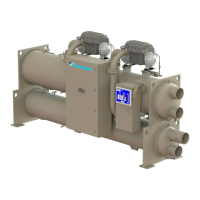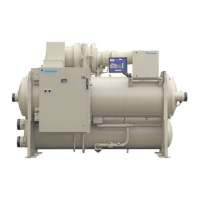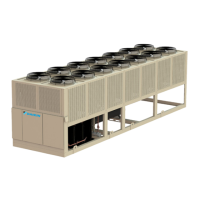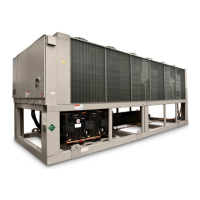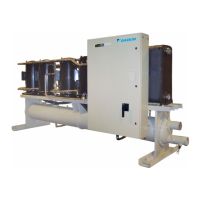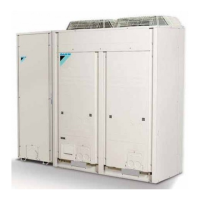TEMPLIfIER
NAVIGATOR WWV/TWVDAIKIN APPLIED
18
Templier
Templier Operating Limits
Templier units are designed to operate over a large range of
temperatures so as to have wide application possibilities. The
following operating limits are based on vessel and compressor
limits.
Table 5: Templier Operating Limits
Description Limit
Maximum allowable condenser water pressure 225 psig (1552
kPa)
Maximum allowable evaporator water pres-
sure
175 psig (1207
kPa)
Maximum allowable water temperature to
evaporator in a nonoperating cycle
105°F (40.5°C)
Maximum entering water temperature for oper-
ating cycle
(for example, during system changeover from
heating to cooling cycle)
90°F (32.2°C)
NOTE:
Contact a Daikin Applied representative for performance at specic
operating conditions, as some limits depend on unit conguration
Table 6: Temperature Limits
Cooling Cycle Min.
Temp
Max
Temp
Notes
Evap Leaving
Water Temp.
40° F 60° F In Cooling Cycle controlling
Evap LWT - The Maximum Set
point temp is 60°F
Cond Leaving
Water Temp
70° F 160° F With Evap LWT above 50°F,
the Cond LWT must be 30°F
above Evap LWT
Evap Water
Delta-T
6° F 16° F
With Glycol in
Evap - Evap LWT
15° F 60° F With Evap LWT below 40°F, the
Cond EWT must not exceed
120°F above Evap LWT.
Heating Cycle
Evap Leaving
Water Temp
40° F 85° F With Evap LWT above 70°F,
the Cond LWT must be 30°F
above Evap LWT
Cond Leaving
Water Temp
110° F 160° F
Evap Water
Delta-T
6° F 16° F
Cond Water Delta - T
with 2 Pass
Cond Water Flow
10° F 15° F Cond Water Temp Delta-T
should be 10°F minimum for
liquid subcooling
with 4 Pass
Cond Water Flow
15° F 40° F
NOTE:
Contact a Daikin Applied representative for performance at specic
operating conditions, as some limits depend on unit conguration
Source Water Piping
The system water piping must be ushed thoroughly prior to
making connections to the unit evaporator. Lay out the water
piping so the source water circulating pump discharges into the
evaporator inlet.
CAUTION
Templier Models must have clean source water from a closed
and treated loop going to the brazed-plate evaporator. For
open water loop applications, an intermediate heat exchanger
between the source water and evaporator is required. Failure to
provide a clean, closed water loop can cause equipment failure
and possible revocation of the unit warranty.
Templier evaporator water can come from various sources
and care must be exercised to avoid sources that can cause
corrosion, fouling, or accumulation of debris in the heat
exchanger. Borderline cases will require a careful and rigorously
performed maintenance schedule.
Heating and Cooling Units
Templier units can be arranged and controlled to act as
either a water chiller or a water heater. These systems vary
considerably in the specics of the piping arrangement. Care
must be exercised when changeover occurs to avoid mixing
water streams that could possibly contaminate a water system.
For example, a unit can have chilled water in the evaporator
and tower water in the condenser when in the cooling mode.
Changeover to heating could put tower water through the
evaporator and hot water (possibly potable water) through the
condenser. This could introduce tower water into the chilled water
system and into the hot water system and should be avoided.
Source/Hot Water Thermostat
The source water temperature sensor is factory installed in the
leaving water connection on the evaporator. The controlling hot
water sensor is in the leaving condenser connection. A sensor is
also located in the entering water connection in order to measure
the condenser Delta-T. Care should be taken not to damage the
sensor cable or lead wires when working around the unit. It is
also advisable to check the lead wire before running the unit to
be sure that it is rmly anchored and not rubbing on the frame or
any other component.
If the sensor is ever removed from the well for servicing, care
must be taken as not to wipe o the heat conducting compound
supplied in the well.
The units can be switched from heating to cooling. In the
cooling mode they are controlled by a thermistor in the leaving
evaporator connection, in the heating mode by the leaving
condenser thermistor.
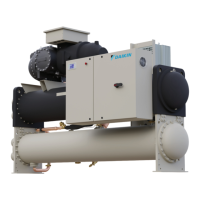
